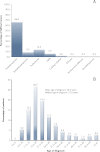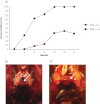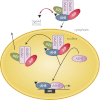Familial isolated pituitary adenomas (FIPA) and the pituitary adenoma predisposition due to mutations in the aryl hydrocarbon receptor interacting protein (AIP) gene
- PMID: 23371967
- PMCID: PMC3610678
- DOI: 10.1210/er.2012-1013
Familial isolated pituitary adenomas (FIPA) and the pituitary adenoma predisposition due to mutations in the aryl hydrocarbon receptor interacting protein (AIP) gene
Abstract
Pituitary adenomas are one of the most frequent intracranial tumors and occur with a prevalence of approximately 1:1000 in the developed world. Pituitary adenomas have a serious disease burden, and their management involves neurosurgery, biological therapies, and radiotherapy. Early diagnosis of pituitary tumors while they are smaller may help increase cure rates. Few genetic predictors of pituitary adenoma development exist. Recent years have seen two separate, complimentary advances in inherited pituitary tumor research. The clinical condition of familial isolated pituitary adenomas (FIPA) has been described, which encompasses the familial occurrence of isolated pituitary adenomas outside of the setting of syndromic conditions like multiple endocrine neoplasia type 1 and Carney complex. FIPA families comprise approximately 2% of pituitary adenomas and represent a clinical entity with homogeneous or heterogeneous pituitary adenoma types occurring within the same kindred. The aryl hydrocarbon receptor interacting protein (AIP) gene has been identified as causing a pituitary adenoma predisposition of variable penetrance that accounts for 20% of FIPA families. Germline AIP mutations have been shown to associate with the occurrence of large pituitary adenomas that occur at a young age, predominantly in children/adolescents and young adults. AIP mutations are usually associated with somatotropinomas, but prolactinomas, nonfunctioning pituitary adenomas, Cushing disease, and other infrequent clinical adenoma types can also occur. Gigantism is a particular feature of AIP mutations and occurs in more than one third of affected somatotropinoma patients. Study of pituitary adenoma patients with AIP mutations has demonstrated that these cases raise clinical challenges to successful treatment. Extensive research on the biology of AIP and new advances in mouse Aip knockout models demonstrate multiple pathways by which AIP may contribute to tumorigenesis. This review assesses the current clinical and therapeutic characteristics of more than 200 FIPA families and addresses research findings among AIP mutation-bearing patients in different populations with pituitary adenomas.
Figures










Similar articles
-
The clinical, pathological, and genetic features of familial isolated pituitary adenomas.Eur J Endocrinol. 2007 Oct;157(4):371-82. doi: 10.1530/EJE-07-0348. Eur J Endocrinol. 2007. PMID: 17893250 Review.
-
Aryl hydrocarbon receptor-interacting protein gene mutations in familial isolated pituitary adenomas: analysis in 73 families.J Clin Endocrinol Metab. 2007 May;92(5):1891-6. doi: 10.1210/jc.2006-2513. Epub 2007 Jan 23. J Clin Endocrinol Metab. 2007. PMID: 17244780
-
Familial isolated pituitary adenomas (FIPA) and mutations in the aryl hydrocarbon receptor interacting protein (AIP) gene.Endocrinol Metab Clin North Am. 2015 Mar;44(1):19-25. doi: 10.1016/j.ecl.2014.10.002. Epub 2014 Nov 4. Endocrinol Metab Clin North Am. 2015. PMID: 25732638 Review.
-
Familial isolated pituitary adenomas: an emerging clinical entity.J Endocrinol Invest. 2012 Dec;35(11):1003-14. doi: 10.1007/BF03346742. J Endocrinol Invest. 2012. PMID: 23310926 Review.
-
Landscape of Familial Isolated and Young-Onset Pituitary Adenomas: Prospective Diagnosis in AIP Mutation Carriers.J Clin Endocrinol Metab. 2015 Sep;100(9):E1242-54. doi: 10.1210/jc.2015-1869. J Clin Endocrinol Metab. 2015. PMID: 26186299 Free PMC article.
Cited by
-
Clinical and Molecular Characteristics of Gonadotroph Pituitary Tumors According to the WHO Classification.Endocr Pathol. 2024 Mar;35(1):1-13. doi: 10.1007/s12022-023-09794-w. Epub 2023 Dec 14. Endocr Pathol. 2024. PMID: 38095839 Free PMC article.
-
Prospective, long-term study of the effect of cabergoline on valvular status in patients with prolactinoma and idiopathic hyperprolactinemia.Endocrine. 2017 Jan;55(1):239-245. doi: 10.1007/s12020-016-1120-5. Epub 2016 Oct 5. Endocrine. 2017. PMID: 27709470
-
Emergence of Pituitary Adenoma in a Child during Surveillance: Clinical Challenges and the Family Members' View in an AIP Mutation-Positive Family.Int J Endocrinol. 2018 Apr 4;2018:8581626. doi: 10.1155/2018/8581626. eCollection 2018. Int J Endocrinol. 2018. PMID: 29849625 Free PMC article.
-
Epidemiology, clinical presentation and diagnosis of non-functioning pituitary adenomas.Pituitary. 2018 Apr;21(2):111-118. doi: 10.1007/s11102-018-0869-3. Pituitary. 2018. PMID: 29368293 Review.
-
RET signalling provides tumorigenic mechanism and tissue specificity for AIP-related somatotrophinomas.Oncogene. 2021 Nov;40(45):6354-6368. doi: 10.1038/s41388-021-02009-8. Epub 2021 Sep 29. Oncogene. 2021. PMID: 34588620 Free PMC article.
References
-
- Daly AF, Rixhon M, Adam C, Dempegioti A, Tichomirowa MA, Beckers A. 2006. High prevalence of pituitary adenomas: a cross-sectional study in the province of Liege, Belgium. J Clin Endocrinol Metab 91:4769–4775 - PubMed
-
- Fontana E, Gaillard R. 2009. Epidemiology of pituitary adenoma: results of the first Swiss study. Rev Med Suisse 5:2172–2174 - PubMed
-
- Fernandez A, Karavitaki N, Wass JA. 2010. Prevalence of pituitary adenomas: a community-based, cross-sectional study in Banbury (Oxfordshire, UK). Clin Endocrinol (Oxf) 72:377–382 - PubMed
-
- Melmed S. 2011. Pathogenesis of pituitary tumors. Nat Rev Endocrinol 7:257–266 - PubMed
Publication types
MeSH terms
Substances
Supplementary concepts
LinkOut - more resources
Full Text Sources
Other Literature Sources
Medical
Miscellaneous

